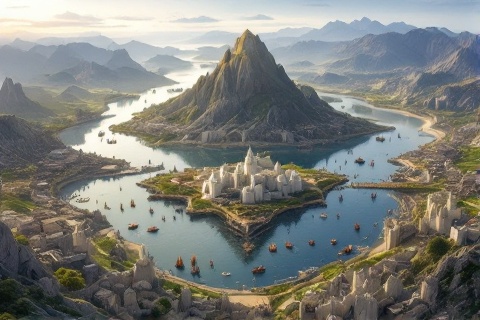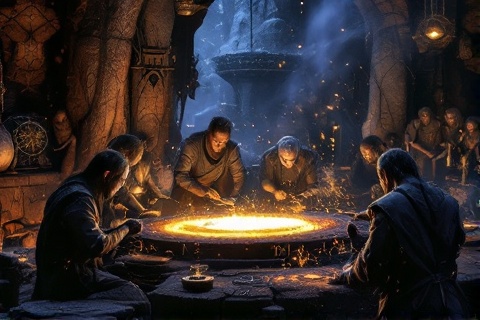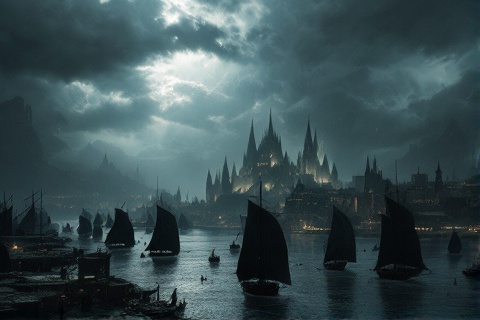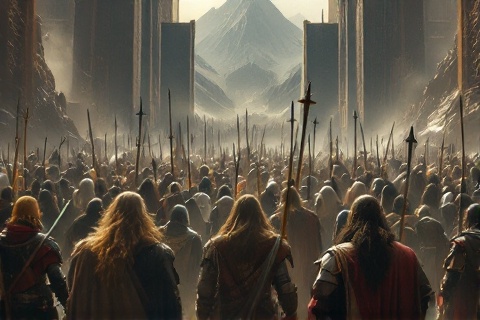
The Shaping of the Second Age: Dawn of Power and Peril in Middle-earth
Unraveling the Epic Tales of Númenor, the Rings of Power, and the Rise of Sauron
The Dawn of a New Era: After the War of Wrath

The dawn of the Second Age emerged from the catastrophic aftermath of the War
of Wrath, which utterly transformed the face of
Middle-earth. The great battles between the Host of the
Valar and Morgoth's forces had sundered the
lands, causing the destruction of Beleriand and the drowning
of vast territories beneath the waves of Belegaer. This reshaping created new
coastlines and geographical features that would define the landscape of
Middle-earth throughout the following ages.
In the wake of these dramatic changes, many of the remaining
Elves who chose not to sail to the Undying
Lands gathered under Gil-galad's leadership to establish
the realm of Lindon. This kingdom, situated in the far
northwest of Middle-earth, became a haven for both Noldorin and
Sindarin Elves. The great havens of Forlond and Harlond were
built along the Gulf of Lune, serving as gateways between Middle-earth and the
Blessed Realm of Valinor.
As the dust of the First Age settled, new realms began to
flourish across Middle-earth. The Elves established powerful kingdoms, with
Celebrimbor founding Eregion near the western gates of
Khazad-dûm, while others settled in forests like Greenwood
the Great. The Edain, those Men who had proven
faithful allies during the First Age, were granted new lands and opportunities
to build their own realms. Meanwhile, the Dwarves reinforced
their ancient mansions in the Misty Mountains, particularly in Khazad-dûm, which
entered its greatest period of prosperity.
The Rise of Númenor: Gift to the Edain

As a reward for their unwavering loyalty during the wars against Morgoth, the
Valar raised the island of Elenna from the depths of the Great Sea. This
magnificent star-shaped island, positioned between Middle-earth and Aman, was a
gift beyond measure. The land was enriched with fertile soil and blessed with a
climate that would nurture the greatest civilization of Men ever known.
Under the leadership of Elros Tar-Minyatur, who chose the fate of Men but was
blessed with extended life, the Edain embarked on a great migration westward.
Their fleet of ships, guided by the Star of
Eärendil, carried them across the Great Sea to
their new home, which they named Númenor. This journey marked
the beginning of a new chapter in the history of Men, as they left the shores of
Middle-earth to claim their promised land.
The first settlers of Númenor quickly established impressive cities and harbors
that would become legendary. The great port city of Rómenna on the eastern coast
served as the primary gateway to Middle-earth, while the magnificent haven of
Andúnië in the west faced toward Valinor. The architects and craftsmen of the
Edain demonstrated remarkable skill in their construction, learning from both
their own traditions and the knowledge gifted by the Eldar.
Thus began the reign of the most powerful kingdom of Men in all of Arda's
history. Under Elros's rule, which lasted for 410 years, Númenor established
itself as a beacon of civilization and learning. The
Númenóreans developed a complex society with noble houses,
skilled craftsmen, and wise scholars. Their extended lifespans, a gift from the
Valar, allowed them to accumulate knowledge and perfect their crafts over
centuries, leading to achievements that would never be equaled by later
generations of Men.
Sauron's Early Deceptions

Following Morgoth's defeat, his lieutenant Sauron fled into the East, evading
the Host of the Valar. During these early years of the Second Age, he remained
hidden in secret places, slowly gathering his strength and followers. The
absence of his master forced Sauron to adapt his strategy, choosing subtle
manipulation over open warfare to achieve his goals of domination.
After centuries of preparation, Sauron appeared in a fair form calling himself
Annatar, the Lord of Gifts. His appearance was noble and
beautiful, and his manner was that of a wise teacher eager to share knowledge.
He claimed to be an emissary of the Valar, particularly of Aulë the Smith, and
approached the Elven-smiths with promises of knowledge that would help them
preserve and enhance Middle-earth.
The smiths of Eregion, led by Celebrimbor, grandson of Fëanor, proved
particularly susceptible to Annatar's teachings. Their desire to create works
that could match the glory of the First Age made them eager students of his
craft. Though Gil-galad and Galadriel distrusted him and refused him entry to
Lindon, the Gwaith-i-Mírdain of Eregion welcomed him, beginning a relationship
that would have catastrophic consequences for all of Middle-earth.
The Forging of the Rings of Power

Under Annatar's guidance, the smiths of Eregion began their work by creating
lesser rings of power. These initial creations served as experiments, allowing
the craftsmen to perfect their techniques and understand the principles of
binding power into physical objects. While these rings held various powers, they
were merely stepping stones toward greater works to come.
The next great achievement was the forging of Seven Rings for the Dwarf-lords.
These rings were crafted with special care, taking into account the natural
resistance of Dwarves to external domination. The Seven were designed to enhance
the natural abilities of the Dwarves, particularly their capacity to create
wealth and great works, though they also kindled in them an even greater desire
for gold and precious things.
Nine Rings were then crafted and given to powerful lords of Men, chosen for
their ambition and desire for power. These rings granted their bearers great
abilities, including the power to command others' wills and to preserve their
own lives far beyond their natural span. However, these gifts came with a
terrible price, as the Nine Rings proved most susceptible to Sauron's
domination.
Finally, Celebrimbor forged the Three Rings of the Elves in secret, without
Sauron's direct involvement. These rings, named Narya, Nenya, and Vilya, were
the greatest and most powerful of all the Rings of
Power save the One. They were crafted to preserve and
protect, not to enhance power for domination. Their creation represented the
peak of Elven ring-making skill, but they were still bound to the same
principles Sauron had taught, making them vulnerable to the One
Ring's influence.
The One Ring and the First War
In the fires of Orodruin, later known as Mount Doom, Sauron secretly forged the
One Ring, the master ring that would control all others. He poured much of his
native power and malice into this creation, making it both his greatest
achievement and his greatest vulnerability. The forging of the One Ring was
accompanied by words that would become infamous: words of binding and domination
in the Black Speech.
When Sauron placed the One Ring upon his finger, the Elves immediately became
aware of his true nature and his desire to dominate all life in Middle-earth.
The bearers of the Three Rings removed and concealed them, refusing to surrender
to his will. This moment marked the end of centuries of deception and the
beginning of open conflict.
Sauron launched a devastating war against Eregion, determined to seize all the
Rings of Power. The realm of Celebrimbor was utterly destroyed, its people slain
or scattered. Celebrimbor himself was captured, tortured for information about
the rings, and ultimately killed. His body was used as a banner by Sauron's
forces, a grim testament to the Dark Lord's cruelty.
The High King Gil-galad, recognizing the existential threat to all free peoples,
sent forces to aid Eregion, but they arrived too late to prevent its
destruction. However, the intervention of Númenor's powerful navy and armies
forced Sauron to retreat from Eriador. This marked the first direct
confrontation between Númenor and Sauron, establishing a rivalry that would
shape the remainder of the Second Age.
Númenor at Its Height

The middle years of the Second Age saw Númenor reach the height of its maritime
power. Their master shipwrights constructed vessels capable of crossing vast
distances, and their mariners mapped the waters of Arda. Under the reign of
Tar-Aldarion, the Guild of Venturers was established, leading to unprecedented
exploration of Middle-earth's coasts and the establishment of numerous colonies.
Along the coasts of Middle-earth, the Númenóreans established a network of
havens and ports. Prominent among these were Pelargir and Umbar in the south,
which became vital centers of trade and cultural exchange. These harbors served
as bases for Númenórean influence in Middle-earth and provided safe havens for
their growing merchant fleet.
Númenórean civilization flourished with remarkable achievements in various
fields. Their architects created structures of unprecedented scale and beauty,
their scholars developed advanced systems of mathematics and astronomy, and
their craftsmen produced works of extraordinary sophistication. The Tower of
Avallónë and the port cities of Númenor became wonders that would never be
equaled in later ages.
As their power and knowledge grew, so too did the pride of the Númenóreans.
Their achievements led them to view themselves as superior to other Men of
Middle-earth, and they began to establish dominion over coastal regions through
both peaceful means and military might. Their ships and warriors became
legendary, and their influence extended far beyond their island home, though
this growing pride would eventually lead to their downfall.
The Shadow Falls on Númenor

Despite their great achievements and extended lifespans, the Númenóreans became
increasingly preoccupied with their mortality. The Gift of Men, as the Elves
called it, became viewed as a curse by many Númenóreans. They began to envy the
immortality of the Elves and resent the Ban of the Valar that prevented them
from sailing westward toward Aman.
This growing discontent led to a deep division within Númenórean society. The
Faithful, led by the Lords of Andúnië, maintained their friendship with the
Elves and their respect for the Valar's wisdom. The King's Men, who became the
majority, turned away from these ancient alliances and traditions, focusing
instead on increasing their power in Middle-earth and seeking ways to escape
death.
The crisis reached its peak when Ar-Pharazôn, the most powerful and proud of all
Númenórean kings, seized the throne through his forced marriage to Tar-Míriel,
the rightful heir. Learning of Sauron's claim to be King of Men, he launched a
great military expedition to Middle-earth. Sauron, recognizing he could not
defeat Númenor's might through force, surrendered and was taken as a prisoner to
Númenor.
Once in Númenor, Sauron quickly rose from prisoner to royal advisor through his
cunning and manipulation. His whispered counsel accelerated the corruption of
Númenórean society, turning them further from the Valar and encouraging the
persecution of the Faithful. He convinced the Númenóreans that physical
immortality could be achieved by conquering the Undying Lands, playing upon
their deepest fears and desires.
The Downfall of Númenor
Under Sauron's influence, Ar-Pharazôn assembled the Great Armament, the largest
fleet ever built in Arda. This vast armada was created with the intention of
invading Aman itself, in direct defiance of the Ban of the Valar. The scale of
this undertaking was unprecedented, with ships filling the harbors and
coastlines of Númenor as far as the eye could see.
When the Great Armament reached the shores of Aman, the Valar laid down their
guardianship and called upon Ilúvatar. His response was cataclysmic: the fleet
was destroyed, and Númenor itself was swallowed by the sea. The destruction
reshaped the world itself, with Aman being removed from the circles of the world
and the formerly flat Earth being made round.
A small group of the Faithful, led by Elendil and his sons Isildur and Anárion,
had heeded warnings of the impending disaster. They escaped the destruction
aboard nine ships, carrying with them heirlooms of great power and significance,
including a scion of Nimloth, the White Tree of Númenor, which Isildur had
rescued at great personal risk.
The Downfall of Númenor marked a fundamental change in the nature of Arda. The
world was made round, and the straight path to Aman became accessible only to
the Elves. This event, known as the Akallabêth in Adûnaic,
marked the end of an era and forever changed the relationship between the mortal
lands and the Undying Realm.
The Founding of the Realms in Exile

Following their escape from Númenor, Elendil and his followers established two
kingdoms in exile: Arnor in the north and
Gondor in the south. These realms were founded to preserve what
remained of Númenórean civilization and to stand against the growing threat of
Sauron, who had survived Númenor's destruction and returned to Middle-earth.
The Exiles built great cities that reflected the glory of their lost homeland.
Annúminas, situated by Lake Nenuial, became the capital of Arnor, while
Osgiliath, straddling the river Anduin, served as the chief city of Gondor.
These cities featured architecture of unprecedented scale and beauty,
incorporating both Númenórean traditions and new innovations.
The survivors brought with them not only physical artifacts but also the
accumulated knowledge and culture of Númenor. Libraries were established to
preserve ancient lore, and schools were founded to pass on traditional skills
and wisdom. The Dúnedain maintained their extended lifespans and their advanced
understanding of healing, crafts, and lore.
Among the most significant acts of the early exile period was the planting of
the White Tree in Minas Ithil. This sapling, grown from a
fruit of Nimloth that Isildur had saved from Númenor, became a symbol of the
enduring connection between the Dúnedain and their ancient heritage. The White
Tree represented both their lost homeland and their continued legitimacy as
rulers blessed by the Valar.
The Last Alliance and Final Battle

As Sauron's power grew once again in Middle-earth, Gil-galad and Elendil
recognized the need for a unified response. They formed the Last Alliance of
Elves and Men, the greatest military coalition since the First Age. This
alliance brought together the armies of both Elven and Númenórean realms, along
with contingents from other free peoples, including Dwarves from Khazad-dûm.
The forces of the Last Alliance laid siege to Barad-dûr, Sauron's mighty
fortress in Mordor. For seven years, they maintained the siege,
facing not only Sauron's armies but also the harsh conditions of the land
itself. The fighting was fierce and casualties were heavy on both sides, as
neither force could gain a decisive advantage.
The climactic battle occurred when Sauron himself finally emerged to face his
enemies. Despite suffering heavy losses, the Alliance achieved victory when
Isildur, using the broken shard of his father Elendil's sword
Narsil, cut the One Ring from Sauron's hand. This act
defeated Sauron, causing his physical form to be destroyed and his armies to be
scattered.
The victory came at an enormous cost. Gil-galad and Elendil both fell in the
final battle, and countless others had perished during the war. Though Isildur
had the opportunity to destroy the One Ring in the fires of Mount Doom, he chose
to keep it as weregild for his father and brother. This fateful decision would
have far-reaching consequences, casting a shadow over the Third
Age and leading to the events that would define Middle-earth's
future.
